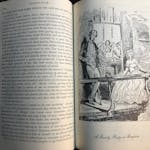I'm a longtime Patti Smith fan. I loved her swagger (and her New Jersey accent) when I first saw her reading poetry (and spitting on the floor) at Hamline University in the mid-1970s, and I loved her lit-rock bravado in concert. She quoted Rimbaud and had a burning desire to communicate. Her music and persona connect me to my late first love, a smart, spirited man who worshiped Patti in eternal fanboy fashion.
It was disappointing, then, how frequently "Year of the Monkey," a memoir/travelogue of Smith's 69th year, was in its opening chapters bewildering, floaty and disjointed. Had the punk downtown poet become Carlos Castaneda?
Smith arrives at the oceanside Dream Inn motel in Santa Cruz, Calif., on New Year's Day, 2016. She and her band have just played three nights at the Fillmore in San Francisco, near where Sandy Pearlman, a dear old music-biz friend, lies dying in a hospital.
Here, chance occurrences are mined for cosmic significance. Smith studies random found objects — a button, some discarded candy wrappers — for talismanic import. As she opens herself to signs and signals like some kind of porous anti-existentialist, she writes, "I had the distinct feeling that something was going to happen. I feared it would be a piercing event, a right-out-of-the-blue thing or worse, a profound nonevent."
Smith's peculiar brand of wandering — dead phone, no car, scant provisions, vague itinerary — takes her and various quasi-mystical fellow travelers to San Diego, Los Angeles and the area around the Salton Sea (a truly bizarre place that she regrettably underexplores). She drinks coffee, hitchhikes, eats fish tacos, recounts her dreams. In a cafe on an ocean pier, she and a stranger named Ernest discuss Chilean writer Roberto Bolaño.
"Year of the Monkey" (which includes 32 charming, quirky photos by the author) gathers strength and momentum as it goes. Smith heads home to New York City in winter, and a West Coast trippy vibe gives way to more concrete imagery, sharper storytelling. There are achingly sweet recollections of travels with a poet named Ray. Smith visits Sam Shepard, whom she dated in the 1970s, and helps the ailing, wheelchair-bound playwright with a final book project. She has a vision of the horse-loving Shepard "listening to a lone stampede," until suddenly she sees "through his mind's eye, the greatest racehorse that ever lived, a white star on his forehead and his back red and glowing like an ember in the dark." For anyone who has thrilled to Smith's song "Horses," this is powerful stuff.
The book has precious little about music. What's there is priceless. Smith's brief description of a tribute concert she gave two days after Pearlman's memorial makes one ache to have been present. Her chapter imagining a "We Are the World" moment with peaceful multitudes dancing to the Go-Go's 1980 hit "We Got the Beat" is at once hilarious and heartfelt.
As her year of the monkey winds down, and "the insufferable yellow-haired confidence man" occupies the White House, Smith mixes hope and despair, elegy and art, dream and reality. In the end, her enigmatic journey has become a fascinating one.
Claude Peck is a former Star Tribune editor.
Year of the Monkey
By: Patti Smith.
Publisher: Alfred A. Knopf, 171 pages, $24.95.






